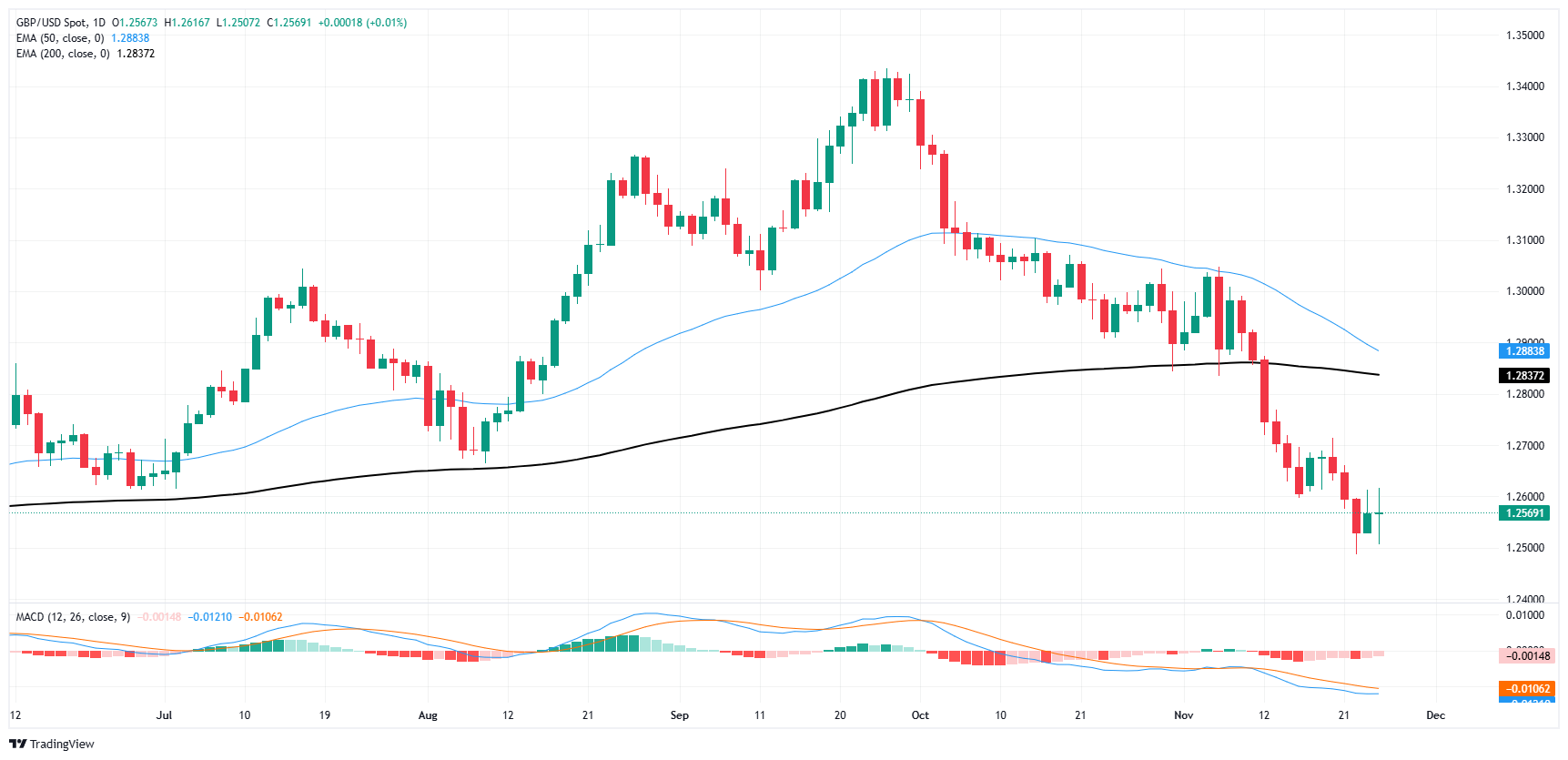- Analytics
- News and Tools
- Market News
- GBP/USD holds steady near the low end
GBP/USD holds steady near the low end
- GBP/USD waffled just below the 1.2600 handle on Tuesday.
- Pound Sterling bidders remain elusive amid data-light schedule.
- Overall market sentiment is twisting ahead of key US inflation figures.
GBP/USD churned chart paper just below 1.2600 on Tuesday, marking out familiar territory as the Pound Sterling struggles to find an intraday direction against the Greenback. A limited data schedule on either side of the Atlantic kept Cable traders locked in place, but looming US inflation data could spark a fresh round of volatility ahead of the US Thanksgiving holiday slated for Thursday.
A raft of financial activity figures from the UK are slated for release on Friday, but the figures are broadly low-tier and will have a limited impact. Some particularly-studious Pound Sterling traders will be keeping one eye on the Bank of England’s latest Financial Stability Report, also due Friday, but market movement is likely to be limited from the print.
Wednesday will bring another update to US Personal Consumption Expenditure Price Index (PCEPI) inflation, a key reading of price increases underpinning the US economy. Wednesday also brings a quarterly update of US Gross Domestic Product (GDP) growth. Annualized core PCEPI inflation is set to accelerate again in October and forecast to increase to 2.8% from the previous 2.7%. QoQ US GDP growth in the third quarter is expected to hold steady at 2.8%.
GBP/USD price forecast
GBP/USD remains hobbled on the south side of the 1.2600 handle, churning bids north of 1.2500 as the pair finds some breathing room after another leg lower from early November’s choppy plateau just below 1.3000. Cable reached a six-month low of 1.2487 late last week, clipping into a 7% decline top-to-bottom from September’s peaks at 1.3434.
In the near-term, Pound bulls hoping for an end to the current Greenback upshot will be looking for intraday bids to return to the 200-day Exponential Moving Average (EMA) near 1.2840, while long-run short positions will be looking for an opportunity to redevelop momentum and drag Cable back to 2024 lows at the 1.2300 handle.
GBP/USD daily chart
Pound Sterling FAQs
The Pound Sterling (GBP) is the oldest currency in the world (886 AD) and the official currency of the United Kingdom. It is the fourth most traded unit for foreign exchange (FX) in the world, accounting for 12% of all transactions, averaging $630 billion a day, according to 2022 data. Its key trading pairs are GBP/USD, also known as ‘Cable’, which accounts for 11% of FX, GBP/JPY, or the ‘Dragon’ as it is known by traders (3%), and EUR/GBP (2%). The Pound Sterling is issued by the Bank of England (BoE).
The single most important factor influencing the value of the Pound Sterling is monetary policy decided by the Bank of England. The BoE bases its decisions on whether it has achieved its primary goal of “price stability” – a steady inflation rate of around 2%. Its primary tool for achieving this is the adjustment of interest rates. When inflation is too high, the BoE will try to rein it in by raising interest rates, making it more expensive for people and businesses to access credit. This is generally positive for GBP, as higher interest rates make the UK a more attractive place for global investors to park their money. When inflation falls too low it is a sign economic growth is slowing. In this scenario, the BoE will consider lowering interest rates to cheapen credit so businesses will borrow more to invest in growth-generating projects.
Data releases gauge the health of the economy and can impact the value of the Pound Sterling. Indicators such as GDP, Manufacturing and Services PMIs, and employment can all influence the direction of the GBP. A strong economy is good for Sterling. Not only does it attract more foreign investment but it may encourage the BoE to put up interest rates, which will directly strengthen GBP. Otherwise, if economic data is weak, the Pound Sterling is likely to fall.
Another significant data release for the Pound Sterling is the Trade Balance. This indicator measures the difference between what a country earns from its exports and what it spends on imports over a given period. If a country produces highly sought-after exports, its currency will benefit purely from the extra demand created from foreign buyers seeking to purchase these goods. Therefore, a positive net Trade Balance strengthens a currency and vice versa for a negative balance.
© 2000-2025. All rights reserved.
This site is managed by Teletrade D.J. LLC 2351 LLC 2022 (Euro House, Richmond Hill Road, Kingstown, VC0100, St. Vincent and the Grenadines).
The information on this website is for informational purposes only and does not constitute any investment advice.
The company does not serve or provide services to customers who are residents of the US, Canada, Iran, The Democratic People's Republic of Korea, Yemen and FATF blacklisted countries.
Making transactions on financial markets with marginal financial instruments opens up wide possibilities and allows investors who are willing to take risks to earn high profits, carrying a potentially high risk of losses at the same time. Therefore you should responsibly approach the issue of choosing the appropriate investment strategy, taking the available resources into account, before starting trading.
Use of the information: full or partial use of materials from this website must always be referenced to TeleTrade as the source of information. Use of the materials on the Internet must be accompanied by a hyperlink to teletrade.org. Automatic import of materials and information from this website is prohibited.
Please contact our PR department if you have any questions or need assistance at pr@teletrade.global.















